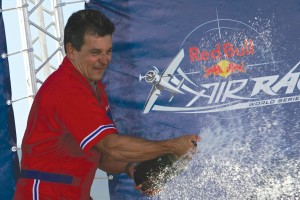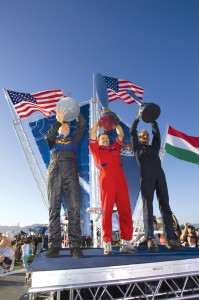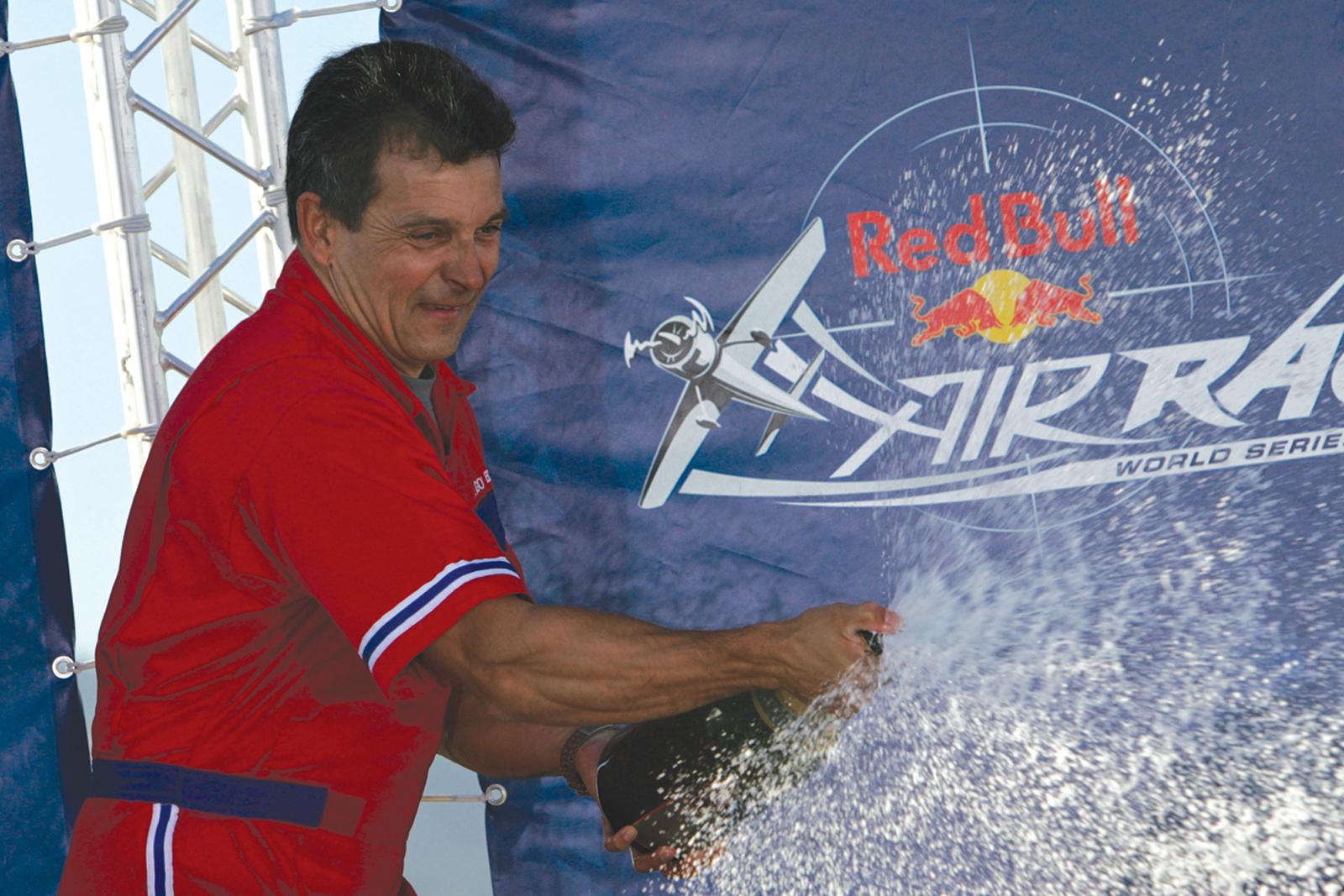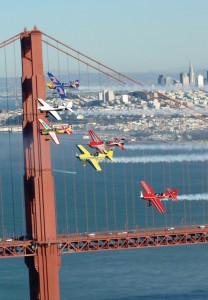By Patty Kovacevich

USA’s Mike Mangold, winner of the recent San Francisco race and the Red Bull World Series 2005, celebrates with a champagne victory before cheering fans.
The Red Bull Air Race idea has taken off with high-octane speed to become one of the world’s leading aviation sports with its own global army of passionate fans who follow this performance sport.
These champion pilots fly between a series of inflated air gates in a stipulated order, performing a series of predetermined aerobatic maneuvers. The goal is to fly as fast as possible with as few penalties as possible. All the while the clock is mercilessly ticking. The rigorous demands require the sharpest pilots in the world with record-breaking qualifications in aerobatic flying and speed maneuverability.
Judging uses a time-penalty system. A three-person jury, including one head judge, monitors pilots’ adherence to rules. Any mistakes while competing in the race track result in the pilot’s being awarded time penalties or, worst case scenario, disqualification.
It’s a thrilling spectator sport for those who watch it, described somewhat like an exhilarating slalom race in the sky that obviously demands expert skill with low-level flying experience and aerobatics. Every pilot’s superb reflexes and aerobatic maneuvers are tested against forces of up to 10 G–about 10 times their body weight
The Red Bull Air Race originated from the lofty vision of two-time World Grand Prix winner Hungarian Peter Besenyei, one of the most famous and successful aerobatic pilots of his generation. Besenyei has won the Flight Aerobatic International World Grand Prix Series and the World Aerobatic Championships twice. He became well-known in 2001after he flew his Extra 300S upside down under Budapest’s Chain Bridge.
The first ever Red Bull Air Race was staged in 2003 at Airpower in Zeltweg, Austria, with Besenyei befittingly the winner. It was followed the same year by an air race at Tokol Airport, Hungary, and three more in 2004 at Kemble, UK; Budapest, Hungary; and Reno, Nev.
Red Bull’s founder and owner Dietrich Mateschitz supported his close friend Besenyei, whose dream was to make the Red Bull Air Race an aviation sport phenomenon recognized throughout the world. Mateschitz’s well known passion for extreme sport combined with Bensenyei’s aviation sports vision were fundamental to the development only two years later of the 2005 first Red Bull Air Race World Series.
“In the beginning air races in 2003, we were faced with so many start-up decisions: course, pilots, aerobatic elements, locations,” Besenyei reflected. “Above all, we didn’t know how we should construct the gates–the slalom poles. We thought of water falls, smoke pillars, illuminated gas, light columns, and even laser columns. But technically, none of those would work.”
Then Martin Jehart and his team came along and developed pylons made of easily torn plastic that remain stable because they’re constantly being pumped full of air from below. The pylons were blown away after the first two races in 2003. Their cylindrical shapes meant they weren’t stable. Jehart, also the mastermind behind the development of the gates and leads, later developed conical pylons that were wider at the bottom and could handle air turbulence.
Those pylons are used successfully today and can easily withstand wind turbulence, which was previously a major cause for race cancellation. Their light material also rips easily when touched by an aircraft wing or propeller and the pylon immediately collapses. A knocked-down pylon is re-erected in four minutes. Any small shred caught on a wing gets chopped up into harmless tiny pieces by razor-sharp blades specially mounted beneath all the planes’ wings.
Red Bull Air Race World Series begins
Those first five races were so well received by adrenaline-fueled fans that Red Bull decided for a global groundbreaking launch in 2005 of the intense Red Bull Air Race World Series Sport. This first year’s world series consisted of eight events stretching across three continents, making the fans part of the competition. The races were held in Abu Dhabi, UAE; Rotterdam, Netherlands; Zeltweg, Austria; Rock of Cashel, Ireland; Longleat, UK; Budapest, Hungary; and San Francisco.
In all, 10 pilots competed in the 2005 Red Bull World Series representing the U.S., Hungary, the United Kingdom, the Netherlands, Spain, France, Germany and Zimbabwe.
“Before the world series launch, it seemed like everything had been done. Something new had to be created to preserve the fans’ interest in aviation aerobatics–something new, really thrilling, and absolutely objective,” Besenyei said. “Aerial aerobatics had previously been measured with too much favoritism and personal taste of the judges, sort of like figure skating. I wanted a more objective, clear set of merits for scoring the pilots’ efforts.”
Worldwide attendance is remarkably impressive, with Rotterdam attracting well over 700,000 spectators and over 1.2 million in attendance in Budapest as media interest exploded news of the series’ launch. Primetime TV in Europe aired the first series, making front page news. Websites are breaking record numbers of online global visitors. In short, we’re all watching the beginning of a world sporting event with its victories and defeats, its bracing competitiveness, and its combination of speed with maneuverability, all performed by the greatest aerobatic pilots in the world.
Each race track is deliberately unique and presents its own set of challenges. Some are designed for speed, while others focus on aerobatic technical skills of the pilots and their machines.
Only special aircraft survive the demands of the Red Bull Air Race unharmed–those of the Unlimited class, which are constructed to withstand up to 15 G. Four different models of planes–the Zivko Edge 540, the Extra 300L, the Sukhoi 29 and Sukhoi 31–could be seen in the 2005 world series.
“Stress limits are no longer imposed by the aircraft–but by the human body,” says Hannes Arch, race director and a top class aerobatic pilot himself.

L to R: Americans Kirby Chambliss and Mike Mangold and Hungarian Peter Besenyei celebrate in the winners circle.
Pilots must fly in four sessions–two in qualifying (round one) and two in the race itself (round two). The winner is the pilot with the fastest aggregate time for rounds one and two, including penalties that may have been incurred. Time penalty infringements include incorrect gate passes and aerobatic maneuvers, touching a gate with any part of the plane and approaching the start line at a speed above the maximum allowed.
Disqualification can result for dangerous flying, for deviating from a specified route and for not attempting to perform a maneuver.
The final stretch
The pilot who finishes with the most ranking points at the end of the season can lay claim to being the finest aerobatic pilot in the world. This year., U.S. pilot and former “Top Gun” Mike Mangold clinched the first Red Bull World Series Championship with 2:27.60 in a climactic race played out in October at San Francisco’s Golden Gate Bridge.
“It feels fantastic,” exclaimed ‘Magnificent Mike,’ as he is affectionately known by fans. “I’m especially humbled by the other top notch and very talented pilots with whom I was competing.”
He said San Francisco was “a bit distracting,” since it’s his home country and state.
“Though I was a native Californian who didn’t have to ship my plane, I had to solve many local problems and logistics that distracted me,” he said. “But once I took care of local problems, I determined I was just going to cruise through the course without any penalties and that’s what I did.”
Mangold knew he had it wrapped up from Budapest. Describing San Francisco as a “finale,” he says he loved the support of family, friends and peers from the Air Force, but thought the overall presentation before the American fans was disappointing. He felt the flight pattern restrictions imposed on the pilots by the local San Francisco management were far too rigid.
“San Francisco unfortunately was too choreographed with all the limitations imposed on us as pilots,” Mangold declared. “I felt this race was inferior to all the others in terms of authentic racing. During the race, and during our practice sessions, the management for the event spent more time telling us how not to fly our planes: ‘Don’t raise your nose up so much. Don’t make that swing wide or that turn too loose.'”
Mangold makes it clear he doesn’t blame the FAA but that private management for U.S. events must realize the importance of keeping this new world series race authentic. He strongly believes that if tight restrictions hover on a pilot’s intense focus for even a quarter of a second, it can easily turn into a full second added into the race.
He says the U.S. has to find a way to thrill and fascinate fans while keeping safety in mind as well. He believes if they don’t achieve that fine line the sport will become more popular in Europe than the U.S., like the Formula One racing circuit, and Americans will lose interest.
“In San Francisco we absolutely contoured our racing skills to meet the control demands of local management,” he said. “Anywhere else in the world we’re flying right above the spectators, bringing the thrill of the sport before each person watching. We’re the best pilots in the world. I’m just one pilot–world champion, of course–but we’ve flown six wonderful races all over the world without incident. This is important in setting the rules and building the excitement for audiences and fans. I passionately want this world series to succeed.”
Mangold said it takes patience and the right amount of competitiveness to win.
“If you’re too competitive, you focus too much on the other teams and not enough on your own performance,” he said. “I’m very aggressive about racing my own plane and racing extremely fast. I’m constantly telling myself to go faster, harder, smarter, relying on my experience and my preparedness as my bag of tricks. Oh yeah, and shoes. Shoes are my other secret. I must have the proper shoes!”
Mangold flew in the Air Force in 1970 during the Vietnam War. He felt if he had to go to war, it would be better to be in the air than in the jungle. He notched 2,500 hours flying in an F-4 Phantom. In 1990, he increased his participation in aerobatic flying and took to it like a duck to water. He competed at his first air race in Reno last year and came out on top in his Edge Dragon. Today he flies with his wife Julie, also an aerobatic pilot, a member of the aerobatic team, and a helicopter pilot for the U.S. Army Reserve.
“Mentally, racing is like being a matador in a bullfight; you absolutely go in to win and your life depends on it,” he said. “Physically, racing is like a boxing match; you get beat around a lot. We move the airplane so violently that I’m sure we’re getting mild concussions the whole time.”
Mangold is used to winning. From 2000 to 2004, he was a member of the U.S. Unlimited Aerobatic Team. He was the Unlimited Aerobatic Champion of California five times and of Arizona twice. He was U.S. and World Champion and placed second two different times at the U.S. Nationals, each time right behind U.S. Champion Kirby Chambliss.
Top U.S. Champions pioneer World Series
Chambliss, five-time National Aerobatic Champion and 2005 captain of the U.S. Aerobatic Team, suffered a time penalty with a final 2:30.31 to trail Mangold for second in San Francisco, putting Chambliss third in world ranking behind Paul Bonhomme. Chambliss declares it’s exhilarating but he’s “not a third-place guy.”
“I’m a go-for-it kind of guy, but I picked up a three-second penalty going too fast out of the gate,” he said. “Three seconds is not much but the .13 seconds in San Francisco was really not something I could tell when I was racing. Our internal timing doesn’t work that well. I was fast. I made a clean run. All I think about when I’m racing is how many G’s I have to pull to get around that next corner and make it to the next pylon.”
Chambliss finished second in the 2004 Red Bull Air Races. One of the world’s finest aerobatic pilots, he’s also known as a very friendly man who fiercely turns on the competitive edge to win once he’s in the air. He named one of his famous maneuvers, “the cobra,” after the aggressive reptile. The aircraft rises up like a snake and stops for a second in the vertical position before dropping to the rear, then presses “angrily” forward. There are very few pilots in the world who can successfully perform this maneuver.
“My motto? First: don’t crash. Second: don’t hit an air gate. Third: be as tough as possible,” Chambliss declares.
Chambliss is also a successful commercial airline captain flying Boeing 737s for Southwest Airlines when he’s not appearing for Red Bull or racing.
“I did seven races for Red Bull this year instead of eight, which dropped me in the ranking,” he said. “Next year I want to concentrate more on the races rather than so many appearances. Focusing on the series next year will help me. I’m very aggressive in the air. You have to be incredibly precise, calm and cool to win at this. If you’re not inwardly clenching your fist, so to speak, the fans will notice. I want fewer distractions for 2006.”
Both Mangold and Chambliss fly a Zivko Edge 540. Zivko Aeronautics of Oklahoma produces the small one-seater airplane with its precision control and aggressive power. The Edge is a shoulder-wing plane with extremely stiff wings. The fuselage is exceedingly stable and resists forces up to 15 G.
Mangold and Chambliss both agree that the Edge is by far the best airplane out there now for aerobatic racing, with its incredible precision, extreme agility and excellent acceleration. But what you’re going to see over the next few years is more research and money invested in aerobatic airplanes designed for speed. Efficiency combined with speed will be imperative.
The future begins now
Rookie camps and safe training are a must for the future of the series and the sport. The first such camps are planned for 2006 with seven-day camps offering top new talent training directly with the Red Bull Air Race pilots. Each country in which an air race is scheduled to take place is encouraged to send a qualified local pilot to the training camp.
“Since it’s so dangerous–actually potentially fatal in the training process–careful consideration and rulings must be implemented,” said Chambliss. “Unlike Formula 1 or Indy training, where crashing into a soft wall means 90 percent of the time you’re going to walk away, if you crash this into the ground or into the water, 90 percent of the time you’re going to die.”
Both champions see the need to help present-day athletes learn safety and risk as they aspire to become future champions.
“We’ll abort a maneuver if we truly sense danger,” Mangold said. “Teaching that to a rookie and helping that rookie cross the line is the fine point. I don’t want to see a huge purse out there lure an aspiring rookie to do something foolish. That’s also where the camps can make a huge difference. … Calculation of safety and daring with a clear head has to be ingrained.”
Both champions emphasize that the series’ pilots flying today are very experienced. They feel a need for more rookie camps to take aspiring pilots safely toward their dreams of racing. The combination of aerobatics with speed and the gradual perfection of the sport must be taught in a safe testing environment that is well thought out. Red Bull has plans for rookie camps in 2006.
When asked if female pilots are a near future possibility, both champions enthusiastically welcome the idea and believe it’s only a matter of time.
The Red Bull Air Race 2006, which runs from March to November, plans to stop in Spain, Germany, Australia and Turkey for the first time as well as making repeat visits to the United Arab Emirates, the U.S. twice, UK and Hungary. The opening event will be March 10 in the UAE. The 2006 World Series then moves to Miami (April), Spain and Germany (May), Turkey (July), Budapest (August), the UK and the U.S. (September) and Australia (November).
“In ten years you’ll see even more races per year in locations throughout the world. Then we’ll truly be established as a sport. By that time, you’ll also be scanning your newspaper for the newest scores in the Red Bull Air Race World Series, just like we do now for other sports,” predicts Peter Besenyei.
Looking ahead on the series’ radar, that vision appears right on target.
For more information, visit [http://www.redbullairrace.com] and [http://www.redbullcopilot.com].












